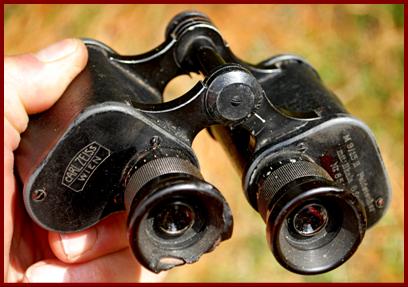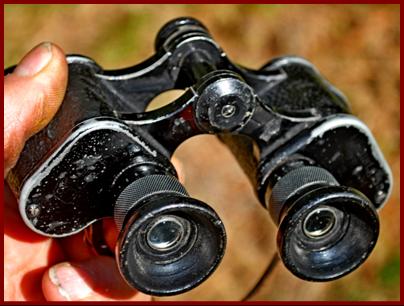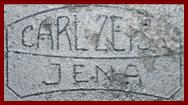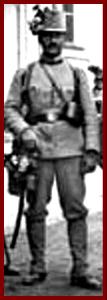|
R.E.L. ( R esearch E nterprises L td 1945 WWII 7X50 Canadian manufactured British Military Binoculars C.G.B.40 M.A. |
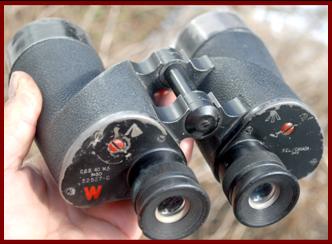


|
The company Research Enterprises Ltd. was created by the Canadian Govt. National Research Council (NRC). The factory was located in what had formerly been the Leaside Aerodrome, near Toronto. |
|
1916 WWI Carl Zeiss London British Military Binoculars 6x24 No.3 Mk II made in Zeiss UK factory. |
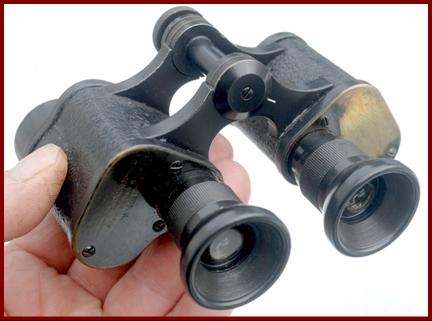

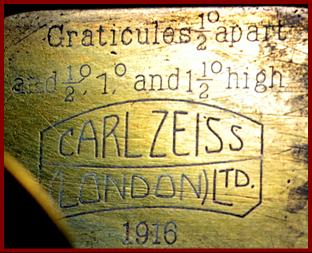
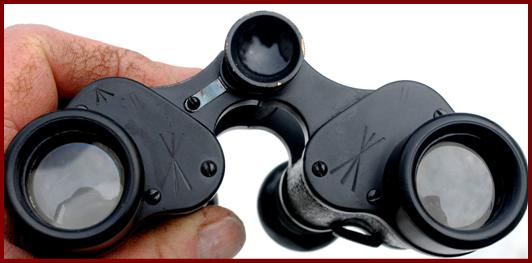



|
My Carl Zeiss London binoculars are a geopolitical binoculars paradox. They were produced in 1916 by the German Carl Zeiss Jena owned but British registered firm of Carl Zeiss London Ltd. (but which by 1916 had it’s German company directors forced out and replaced by British ones) at it’s Mill Hill London factory, fulfilling British Ministry of Defense govt. contracts, around two years after the UK had declared war on Germany on Aug. 4, 1914 (my grandmother’s brother Percy enlisted in London that month) with those binoculars equipping UK troops fighting German troops. Zeiss London produced at least 923 of these binoculars in 1916. Slightly before the war had started, Carl Zeiss Jena ordered a stock of 700 binoculars from the London factory to be sent to Germany, but those shipments were blocked at British and Dutch ports, and the binoculars redirected to Woolrich arsenal in England. Actually the Carl Zeiss London factory had been producing British Military No 2 Mk I & Mk II and then No 3 Mk I and Mk II binoculars since 1909, when Carl Zeiss London Ltd. had been formed for that purpose. The British government subsequently forced the liquidation sale of the assets of Zeiss London Ltd. including the factory and all manufacturing equipment to the British Optics firm Ross Ltd. in January 1917, under the regulations of the January 1916 Trading With The Enemy (Amendment) Act for liquidating enemy owned property, with proceeds held in trust. Ross promptly continued to fill the Zeiss London Ltd. British Military contracts by producing around 50-75 binoculars per week, but with the subsequent binoculars branded as Ross. (information credit to Thomas Antoniades/ “ Carl Zeiss Presence in London”). See my Ross Mill Hill binoculars below. |
|
“Binocular Prismatic No 3 Mark II magnification 6, (serial) No 1504”. The Mk II designates having the range graticule defined on the right plate, but the ocular was replaced with one from a No 3 MK1 model minus graticule, probably at the time of military disposal as a form of “demilitarizing”. |
|
One broad arrow British Military property mark at upper left, and two facing broad arrow property disposal marks |

|
Japanese External Reverse Porro Prism Binoculars. WEBSITE MUSEUM |
|
OTHER BINOCULARS #8 & OPTICAL SIGHTS/MOSTLY MILITARY |
|
1960 Russian T3K 10x80 Flak and Observation Binoculars made by the Russian Novosibirsk Instrument Making Plant ( Новосибирский приборостроительный завод ), and Sold to the Iraq Army, and then Combat Damaged by Airburst Shrapnel in the Iraq War of 1992 |
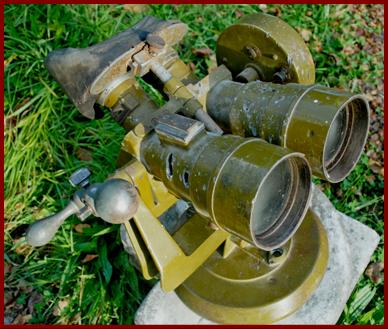
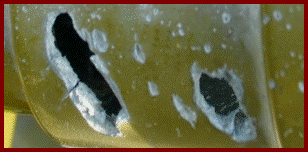
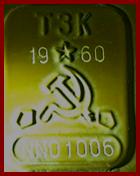
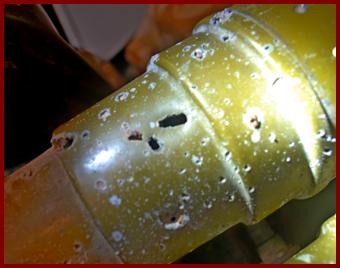
|
The Novosibirsk factory logo incorporates two pentagons with hammer & sickle and uses “N” prefix on serial numbers |
|
Some of the ferrous airburst anti personnel shrapnel that peppered these binoculars is still embedded in the metal of the objective tubes. |
|
These Russian 10x80 flak or anti aircraft binoculars were modeled on similar WWII German flak binoculars, and these were designed to be tripod mounted. Like the German models, these were also sometimes used as ground emplacement observation binoculars. These were probably brought back to the United States as a war trophy souvenir by a US soldier, and to me these particular binoculars are more interesting for their war damage and for the graphic insight they provide into the role of optics at war that they provide. The right side optics on these have targeting circles, and the base and the elevating mechanism both have directional and elevation readouts, which in it’s original flak or anti aircraft or searchlight role gave fire control/ height burst or direction corrections. |


|
1948-1952 U.S. Occupation German 7x50 Binoculars made under contract for Canadian Simpson’s Department Store Chain by Hartmann Optik (Porlerim Model) |
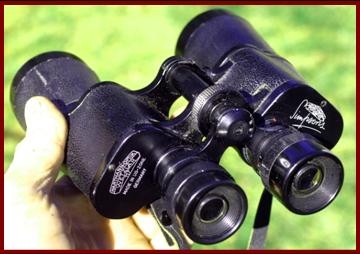
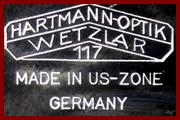
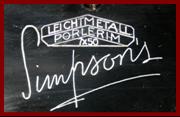
|
My Hartman-Optik 7x50 Porlerim binoculars are marked as having been made in the US Zone of Occupied Germany (1945-1952). Hartman was allowed to resume binocular production in post war Germany in 1948, and did so in 1948 with this Porlerim model line. These binoculars are marked as being made of the hard aluminum alloy “ LEIGHTMETALL ”. These binoculars also carry the stylized “ Simpson’s ” corporate logo of the Canadian Department store & mail order chain of Robert Simpson Ltd., which in 1952 had stores in Toronto, Montreal, Halifax, Regina, and London (Ontario) Canada. So Hartmann Optik made these under contract for the Simpson’s store chain at some point between 1948-1952 |
|
R.E.L. ( R esearch E nterprises L td.) 1944 and also 1945 WWII 6X30 Canadian Manufactured British Issued Military Marked Binoculars |

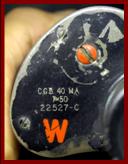
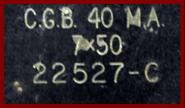
|
My 1944 and my 1945 dated Canadian manufactured R.E.L. 6x30 British military binoculars were produced by R.E.L. / Research Enterprises Ltd., and share history with the 1945 7x50 R.E.L. 7x50 binoculars above. They are British MOD broad arrow property marked, and the 1944 one example was obtained in England. My 1944 binoculars SN 31418-C are marked C.G.B. 53 G.A. and my 1945 binoculars SN 66303-C are marked C.G.B. 37 M.A. and had a 1953 inspection tag. There is thinking that C.G.B. is “Contract Great Britain”, but per “Tales from the Supply Depot” it may be a commonwealth stores code, with G.B. meaning supplied with case. The 1945 example came with a Canada broad arrow 1943 dated case. R.E.L. appears to have made around 62,812 of these 6x30 binoculars. |
|
WWI 1914 Hungarian Zeiss Karoly Gy ö r M9/13 Z, K.U.K. Kaiserlich und Kongigliche Armee 6x 30 Austo Hungarian Army military binoculars made in the Zeiss Gy ö r Hungary factory. |
|
In 1911 the Carl Zeiss branch located in Vienna Austria established an assembly factory in Gyor Hungary, and in March 1914 it was incorporated as Zeiss Karoly R.T.(R é szv énytársasg/ public limited company). My Zeiss Karoly binoculars are marked 9/13 Z being a 1913 modification of the Zeiss 1909 model, and are marked 6 Facht , or 6 power. They are marked Feldstecher mit Skala (field glasses with scale, in German). My 7/31/1914 dated binoculars were made for the Austro Hungarian Army/ K.U.K./ Kaiserlich und Kongigliche Armee/ Imperial and Royal Army, and contain a right side graticule, and have the the UK (Ubernahme Kommison of the Artillery) acceptance mark with Austrian imperial crown. Info credit : Zeiss Historica, Vol 12 No 1. |
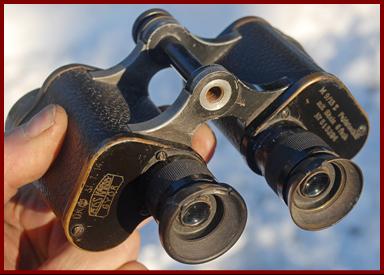
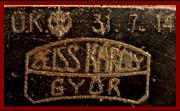

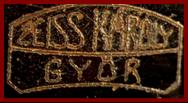
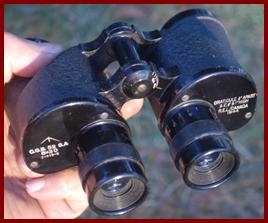
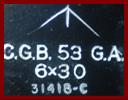

|
(outrageous) HONDA 50 cc “MONKEY” MOTORCYCLE MINI BIKE THAT I CREATED ?????? |

|
1912 Russian Zeiss St. Petersburg DF 8x24 Russian Army military binoculars with reticule/ graticile/ ranging grid, made or assembled in the Carl Zeiss St. Petersburg Russia facility. |
|
My 1912 Zeiss DF (Doppel Fernrohrglas) 8x (8x24 )military binoculars with right ocular reticule/ ranging grid were made at the Carl Zeiss St. Petersburg Russia facility, which had been established in 1911 as part of Carl Zeiss foreign assembly expansions By recommendation of the Russian artillery committee of the GAU ( Главное артиллерийское управление (ГАУ – GAU ), these 8x binoculars were ordered by the Officer Rifle School to equip officer graduates of the artillery military schools from 1911-1913, while graduates of non artillery military schools received 6x models. (and in 1914 Russia standardized on 6x30 field binoculars for all). Only a small quantity of these 8x24 models are thought to still exist, given the small quantity produced for a small group of recipients, and given 110 years, the revolution; imperial officer purges, and several wars. These are serial number 296428 and also are numbered 328 (presumably #328 of this military contract) |
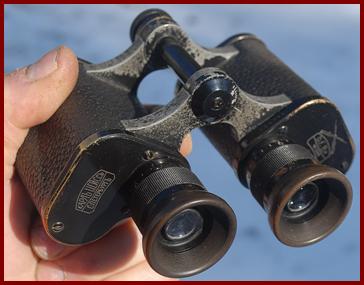
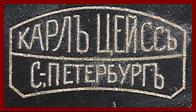
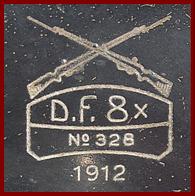
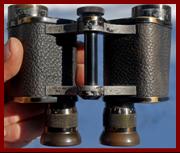

|
Israel Defense Force IDF contract Binolux 6x35 military binoculars |
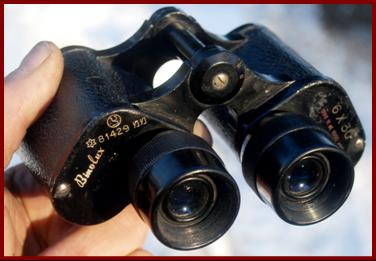
|
My Binolux 6x35 binoculars carry the Israeli govt. property marks of letter Tsadi in circle and letter Nun in the star of david (also commonly seen on firearms Israel acquired in the 1950’s/1960’s for their military), and seem to be Binolux civilian spec binoculars purchased under an IDF /Israel Defense Forces contract. The T615184 is consistent with Binolux serial numbers, and the 81429 after the star of david property mark followed by the word for number in Hebrew is presumed to be a government property number. |
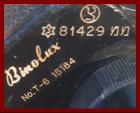



|
The German firm of Carl Zeiss had a formal company presence in London England starting in the 1840’s, in addition to their retail dealers, and in 1897 a Zeiss branch was advertised at 29 Margaret Street London West. On Nov 9, 1909 Carl Zeiss formally created a limited company in England, but with share capitol held by Carl Zeiss Jena Germany, and part of the reason for this was probably to pursue British government contracts as a UK entity. My 1913 dated Carl Zeiss London British Military Binoculars prove that Zeiss was assembling their No 3 Mk1 British designated military binoculars at their Mill Hill London factory facility in 1913, in order to fill UK Ministry of Defense (MOD) contracts. Their Mill Hill facility is shown left. (information credit to Thomas Antoniades/ “ Carl Zeiss Presence in London”). See also additional information about the activities of Zeiss London during WWI posted below with my 1916 No 3 Mk II Zeiss London military binoculars below. |
|
1913 pre WWI Carl Zeiss London British Military Binoculars 6x24 No.3 Mk 1 made in Zeiss UK factory |
|
Simpson’s mail order office, Sarnia, Ont., 1952. (Sears Canada. Photo Engravers and Electrotypers Ltd. Library and Archives Canada, e011172139 / Flickr), CC BY |
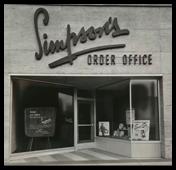
|
Simpsons ca 1952 |
|
1894 Carl Zeiss subsidiary in London Images donated as part of a GLAM collaboration with Carl Zeiss Microscopy . licensed cc by-sa 2.0 |
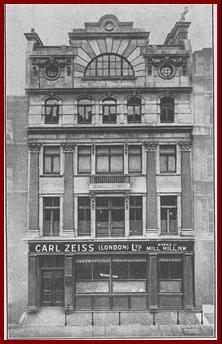
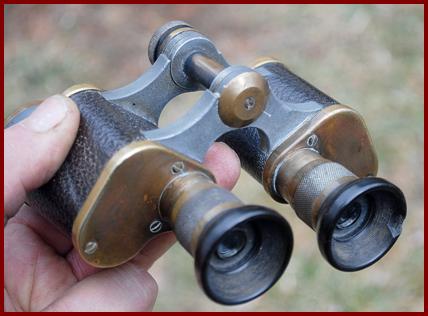
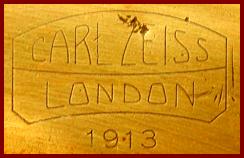

|
“ Binocular Prismatic No 3 Mark I magnification 6, (serial) No. 3945 ”. |
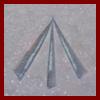
|
MOD/ Ministry of Defensebroad arrow property mark |
|
Carl Zeiss London Mill Hill (Wikepedia Creative Commons) |

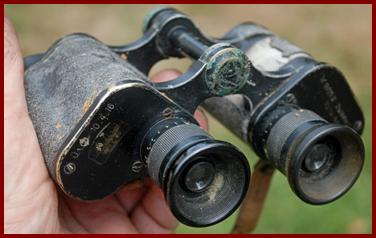
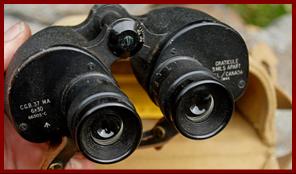
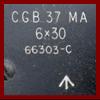


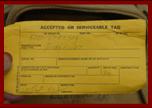

|
1915 WWI Carl Zeiss Jena German made Austro Hungarian 6x30 D.F. 6x Military binoculars |
|
The Carl Zeiss Wien (Vienna) Austria affiliated assembly factory operated from 1902-1926. My military binoculars are marked M9/13 Z (Zeiss Model of 1909/ acceptance 1913) serial 554909 and have a marked production or issue date of 10/4/16 (1916), and has a UK (Ubernahme Kommison of the Artillery) acceptance mark with Austrian imperial crown. (Partial Information credit Frank Florio). |


|
1917 WWI Ross London Mill Hill British Military Binoculars 6x24 No.3 Mk II/ ex Zeiss UK factory |
|
My 1917 Ross Mill Hill London f actory binoculars reflect the forced assets liquidation takeover of Zeiss London Ltd. by Ross Ltd. in January 1917, who then proceeded to fill the Zeiss London Ltd. British military contracts for No.3 Mk II binoculars in 1917 and 1918, with these binoculars marked Ross, London (Mill Hill) and being made on the same Zeiss London machines and in the same premises and with the same workers. These binoculars are marked as having belonged to 2nd Lieutenant RJ. Walker of the R.F.A./ Royal Field Artillery, but by not having his exact first name I was not able to identify his WWI records. These binoculars were acquired in a 1916 dated Wolfsky & Co. London No 3 prismatic binoculars case. |
|
1916 WWI Carl Zeiss Wien (Zeiss Vienna Austria factory) Austo Hungarian 6x30 Military binoculars |
|
My 4/6/1915 dated Carl Zeiss Jena German made DF (Doppel Fernrohrglas) 6x military binoculars serial number 535627 are maked as accepted Apr.6, 1915 and have a UK (Ubernahme Kommison of the Artillery) acceptance mark with Austrian imperial crown, and were made as a contract to the Austro Hungarian army. |
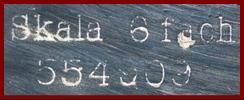
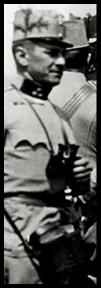
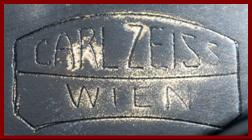


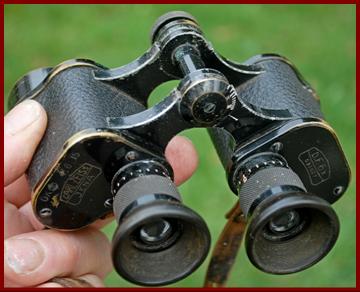
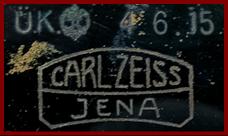
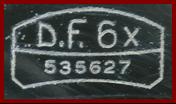
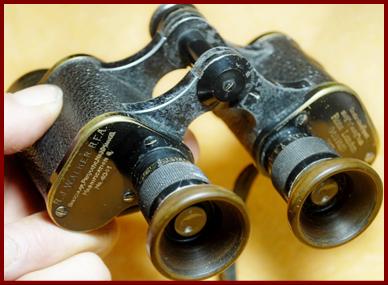

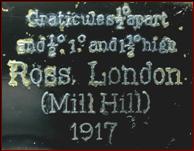


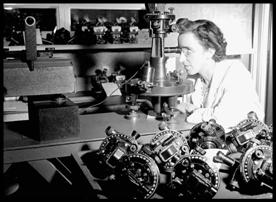
|
R.E.L. worker testing gun sights during summer1943 |

|
1913 French made E. Krauss 6x binoculars made under contract to the the Russian Главное артиллерийское управление (ГАУ – GAU ) for graduates of the non artillery military schools |
|
As above, I believe my 1913 French E. Krauss military binoculars were made for the Russian non-artillery Schools under instructions of GAU to be issued to their graduates (probable, but speculative, and based on the crossed rifle emblem that was used by these Russian military schools). E. Krauss made lenses, binoculars, cameras, and telescopes 1892-1030’s, including under Zeiss license, and including military contract binoculars . |
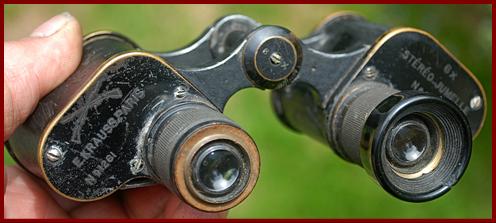
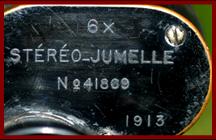
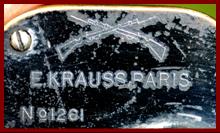

|
Serial number 1261 |


|
6 power with scale |
|
CONSTANTLY NEWLY ADDED ITEMS ARE INSERTED THROUGHOUT THE SECTION |
|
NON MINIATURE BINOCULARS AND OPTICS: MOSTLY MILITARY |


|
1917 WWI C.P. Goerz Wien u Pozony (Goerz Austrian factories) Mit Skala M9 Feldstecher (With Scale Model 9 Field Glass) Austo Hungarian Army 6x30 Military binoculars serial #32695 |
|
Around WWI C.P. Goerz had factories in Vienna and Pozony (Pressburg, now Bratslavia Slovak republic) in Austria. My military Goerz binoculars are marked as accepted Nov 27, 1917, and are marked 6 fach (6 power) and has a UK (Ubernahme Kommison of the Artillery) acceptance mark with Austrian imperial crown. They are “mit skala” and have a graticle/ range grid. In 1923 Goerz was bankrupt and was bought by Carl Zeiss. |
|
1913 C.P Goerz Wein Pozsony M9 k.k. Landwehraras (Kasiserich-Konigliche-Landwehr) WWI Cisleithanian Austrian Territorial Army Binoculars with right ocular graticule/ ranging grid |
|
My C.P. Goerz M9 Feldstecher 6 fach Mit Skala (model 1909 field glasses 6 power with scale) were manufactured at the Goerz Pressburg/ Pozsony factory in Bratislava Austria (established in 1908), with the Vienna and Pozsony factories dedicated to military optics contract production. My model 9 binoculars are property marked Eigentum des k.k. Landwehrarars (property of the kaiserich konigliche Landwehrararars), which was the territorial army of the Cisleithanian/ (Austrian part of the Austrian Hungarian Empire) from 1869-1918. Landwehrarars members are pictured during World War I in 1914 at left. |
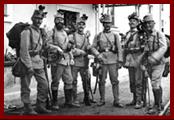
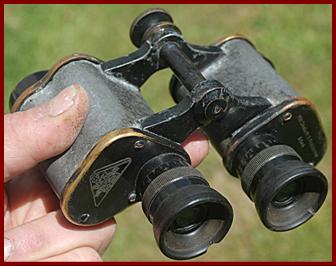

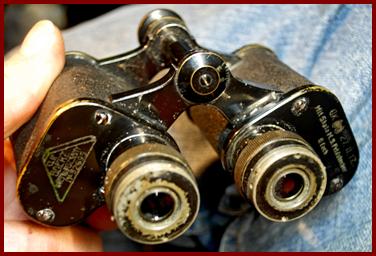
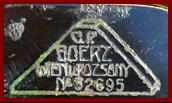
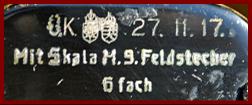
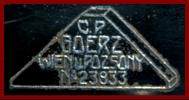
|
My 1945 dated R.E.L. 7x50 C.G.B.40 M.A. military binoculars were produced by Research Enterprises Ltd., a Canadian war factory that existed from late 1940-1946. |
|
R.E.L. produced around 25,000 of these 7x50 binoculars, which were used by Canada, the UK, probably other commonwealth countries during WWII, and into the 1950’s. These particular binoculars are UK broad arrow War Dept military property marked, and also carry the red ’ W ” W aterproofed marking, and aso have the red painted screw heads indicating sealed/ removal by authorized repair personnel only. The R.E.L optics factory also produced 6x30 military binoculars, such as those below, and also produced several Canadian manufactured versions of the British #32 sniper scope used on the Lee Enfield #4 Mk1*T sniper rifles, as well as optical tank and artillery gunsights, and observer’s telescopes. R.E.L.’s electronics factory also produced a wide variety of radar systems, many of which were sold to the US military. |
|
WWI Carl Zeiss Wien (Zeiss Vienna Austria factory) 6x30 Military binoculars |
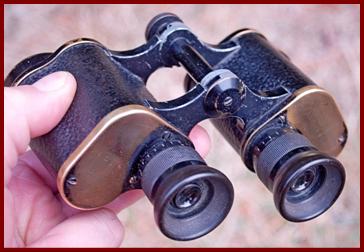


|
Like the 1916 Carl Zeiss Wien binoculars above, my slightly earlier production Zeiss Wein (Vienna) binoculars serial # 406774 were made at the Austrian Zeiss factory , and are marked M9/13 Z (Zeiss Model of 1909/ acceptance 1913, and are marked mit skala6 fach (with scale 6 power) but do not actually have a graticule. I understand this is not unusual on these. Unlike the above binoculars above these do not have any UK mark or Austrian crown, but these probably were Austo-Hungarian army issued. |


![Text Box: CLICK ON PAGE LINE. CLIQUEZ SUR LA LIGNE DE PAGE. KLICKEN SIE AUF SEITENZEILE. HAGA CLIC EN LÍNEA DE PÁGINA..[ページ行]をクリックします。НАЖМИТЕ НА СТРОКУ СТРАНИЦЫ. ALSO SEE INDEX.](image3473.gif)
|
1915 WWI C.P. Goerz Wien u Pozony (Goerz Austrian factories) M8 Armee Feldstecher ( Austo Hungarian Army 6x Military binoculars serial #19465 |
|
Around WWI C.P. Goerz had factories in Vienna and Pozony (Pressburg, now Bratslavia Slovak republic) in Austria. My military Goerz binoculars are marked as accepted June 16, 1915, and has a UK (Ubernahme Kommison of the Artillery) acceptance mark with Austrian imperial crown. |
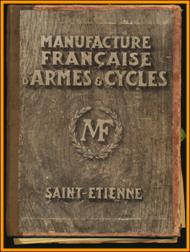
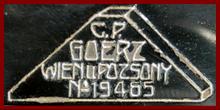
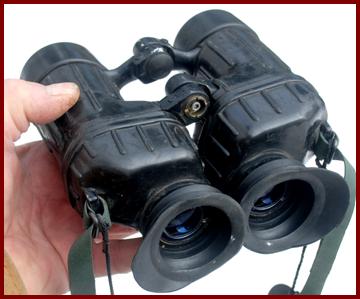
|
Carl Zeiss Wien M9/13 Z Feldstecher mit scala k.k. Landwehrarars (Kasiserich-Konigliche-Landwehr) WWI Cisleithanian Austrian Territorial Army Binoculars with right ocular graticule serial #851482 |
|
My Carl Zeiss Wien M9/13 Z Feldstecher 6 fach Mit Skala (model 1909/ accepted 1913) field glasses 6 power with scale) were manufactured at the Zeiss Austrian factory My Zeiss binoculars are property marked to the k.k. Landwehrarars (kaiserich konigliche Landwehrararars), which was the territorial army of the Cisleithanian/ (Austrian part of the Austrian Hungarian Empire) from 1869-1918. |
